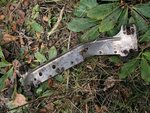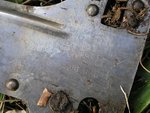What could that be? This part was found at a crashplace of an 4 engined american aircraft.
You can read "FRONT", the number: "33D5227 and "TYPE-B-7 100-1100". Attached you will see the pictures.
Thanks for your help! - Kurtl
You can read "FRONT", the number: "33D5227 and "TYPE-B-7 100-1100". Attached you will see the pictures.
Thanks for your help! - Kurtl


